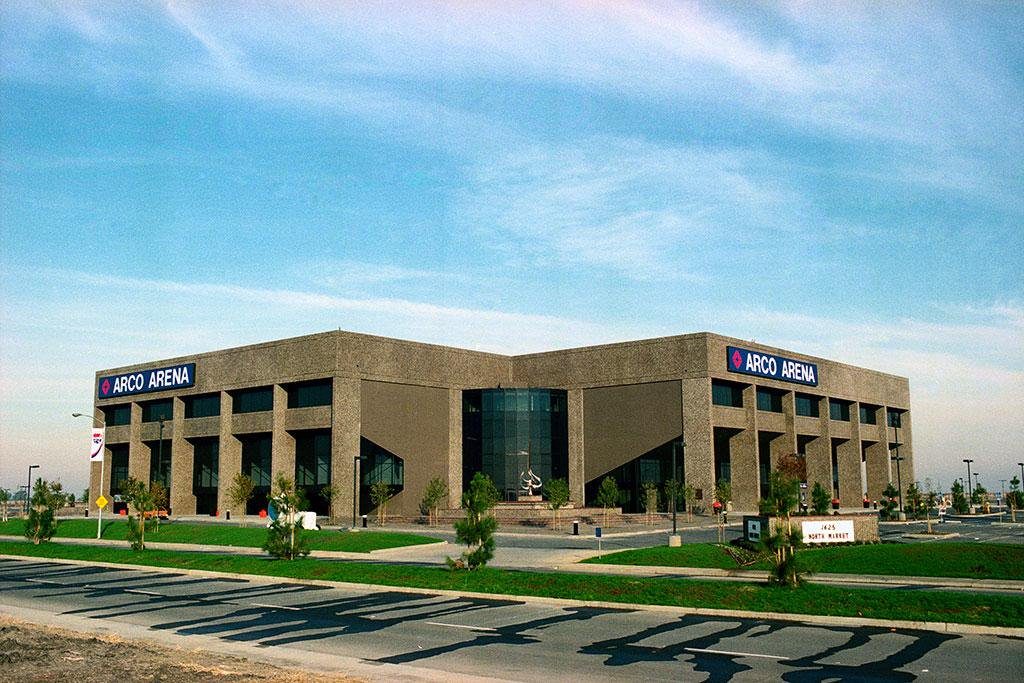
When the Sacramento Kings debuted in their new city in 1985, they did not yet have a permanent home. With a new arena still a few years away from completion, the franchise began its run in California’s capital city in a small, temporary venue still standing as an office building more than 30 years after its final NBA game.
Beginning with the move of the Rochester Royals to Cincinnati in 1957, the current Kings franchise relocated several times in a period of less than 30 years. The Royals’ stay in Cincinnati lasted until 1972, when they relocated to become the Kansas City-Omaha Kings, only for the Kansas City Kings moniker to be adapted in 1975.
By the early 1980s, however, there were signs the Kings could be on the move again, as they were purchased in 1983 for $10.5 million by a group of investors from Sacramento. Failed negotiations for new lease terms at Kansas City’s Kemper Arena, combined with problematic financial and attendance situations, prompted the group to announce in January 1985 that it had asked the NBA for permission to relocate the franchise to Sacramento beginning in the 1985-86 season.
The NBA approved that move in April 1985, contingent upon the construction of a new arena. It was known, however, that a new arena would not be ready immediately, requiring the Kings to plan on playing their initial Sacramento seasons in what the Chicago Tribune described as “a temporary structure seating 10,000.”
Eventually named ARCO Arena, the scope of the structure reflected its temporary nature. The venue was a small one—seating just 10,333—with locker rooms cited as the smallest in the league, and just four suites (one in each corner). Its planning and opening came as Kings owners planned for a new NBA arena to be constructed at a nearby site, with the concept for that facility more closely reflecting modern NBA standards.
While ARCO Arena might not have had the look and feel of a typical NBA arena, it nonetheless proved to be a good launching point for the Sacramento Kings. Games sold out consistently, as the Kings averaged 10,333 fans per game in each of their three seasons in the venue. The sellouts came despite their lack of success on the court, as the Kings failed to record a winning record over that stretch. Strong attendance numbers also made for a unique atmosphere, as the close proximity between the fans and the players—a mere 120 feet separated the farthest seat from the court—is remembered for fostering a raucous atmosphere.
After three seasons at their temporary home, the Kings moved to the new ARCO Arena, just a couple of miles from its predecessor. As had been planned from the onset, the original ARCO Arena ceased to operate as a sports and entertainment venue, allowing it to be converted into an office building.

More than 30 years later, the former arena remains standing as an office building at 1625 North Market Blvd. in Sacramento. Sprint Communications had operations there for a number of years, but the building is now home to the California Department of Consumer Affairs. Even with its conversion on the interior, the structure’s exterior looks nearly identical to how it appeared during the its days as NBA arena.
For the Kings, the move to the new ARCO Arena would precede a stretch that include more productive runs on the court. The new ARCO Arena—later Power Balance Pavilion, and then Sleep Train Arena—lasted as the team’s home through the 2015-16 NBA season. At the beginning of the following the season, the Kings moved into the brand-new Golden 1 Center, the downtown Sacramento arena that continues to be billed as the anchor of a larger redevelopment initiative in the surrounding area.
With the original ARCO Arena, Sleep Train Arena, and the Golden 1 Center all still standing, Sacramento can boast the claim of having three NBA arenas remaining at least partially intact. That is not expected to be the case permanently, though, as discussions about redeveloping Sleep Train Arena site are underway. The original Arco Arena remains standing, however, with its presence providing plenty of reminders of the franchise’s early years in Sacramento despite no longer serving as an arena.
Top image courtesy Golden 1 Center. Image of building in post-arena form courtesy California Department of Consumer Affairs.
This article originally appeared in the weekly Arena Digest newsletter. Are you a subscriber? Click here to sign up for the free weekly newsletter
Previous Arenas That Live On Entries:

